Interview with Washington Wachira about Crowned Eagles in Kenya
In this interview, Washington Wachira talks about his project studying urban Crowned Eagles in Nairobi, Kenya.
Washington has recently given a wonderful TED Talk called: For the love of birds
Make sure to also watch Washington’s video on Youtube about Crowned Eagles: URBAN CROWNS FILM, WASHINGTON WACHIRA, 2017
The video is also embedded in this page at the end of the interview.
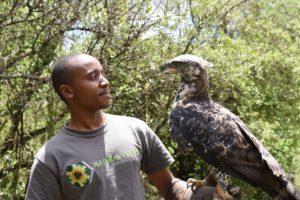
Photo by Simon Thomsett
What is the scope and focus of your project?
My study aims at establishing the nesting requirements, selection criteria and dietary needs of urban African Crowned Eagles in Nairobi, Kenya. I have been expanding to other parts of Kenya and hopefully will study the entire country in future; but this first phase focuses mainly on the greater Nairobi.
The greater objective of my work is to promote the species conservation by involving ambassadors in public awareness. Secondly, the project aims to inform policy makers on the status of African Crowned Eagles in Nairobi, a fast growing city. From the study, local policy makers will be engaged in promoting the profile of the species and awareness creation among the general public to reduce persecution. In line with this I have been conducting environmental education sessions; mainly targeting the youth under 35 years in Nairobi. The two recent activities engaged:
-
A team of young birders from the Youth Africa Birding- Kenya; enjoyed visits to forests that host African Crowned Eagles nests and had day long discussions with the project team
-
National Geographic Photo Ark Challenge (PACI) event; with the slogan “Eagles are Cool”
We hope that in future years, Crowned Eagles will be appreciated as majestic raptors that deserve to live in Nairobi, among other biodiversity.
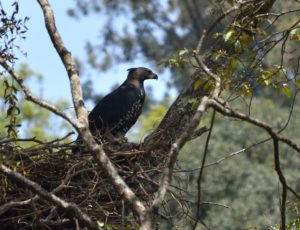
How many territories are you monitoring?
I have five pairs currently occupying territories in the greater Nairobi, four of which have nested successfully in the past two years. These five nests are located inside urban forests in the greater Nairobi region.
However, there is one more nest that has been reported in a residential compound. Having seen the nest, it looks potential for a possible territory. Though, I am yet to fully verify whether it is a new pair, but through photo comparisons shared by the citizen-scientist/observer, I am quite convinced there is a sixth pair.
How big are the Crowned Eagle territories?
In Nairobi, the territory sizes seem to be based in forests bigger than 700 hectares. All the currently occupied forests in the greater Nairobi region are at least 700 hectares or more; but all vary in maximum size.
On a global scale, or rather in the entire African population- viewed in general, the territories of this species are determined by resources- mainly food and nesting grounds. If an area has enough resources, pairs can get very close and co-exist. Where resources are scarcer, the reverse is true. I have personally observed this in the Kenyan highlands, where a forest hosts multiple pairs very close to each other; because the prey base and the nesting sites are abundant.
What is the main habitat for Crowned Eagles in Nairobi?
African Crowned Eagles prefer to live in wooded habitats; and are well adapted for life in the woods. Their long tail and broad wings give them an Accipiter-like maneuvering ability. Maybe a good reason why they still feel like Hawk-Eagles each time you observe them in the field.
The Nairobi pairs are mainly centered around the nesting sites; which are the large urban forests. They prefer to spend most of their time inside natural forests as per my observations; which could be linked to the available food in natural forests. However, I have records of eagles straying across the entire city and at times ending up in very largely built zones. I received one interesting record from a friend where one individual had perched in a tree in an urban estate and was mobbed by Pied Crows for hours. They have also turned up at the Nairobi Museum, which is not much of a forest.
What is the preferred nesting tree?
This is a very interesting one, as I was very keen to observe this when I was starting. To my amazement, every pair has nested on a different tree species- Eucalyptus sp., Ceiba sp., Croton sp., Albizia amara, Albizia gummifera and Newtonia sp.
From these records, the genus Albizia is the only repeated genus even if the species are different.
Generally, the Nairobi pairs prefer indegenous trees as opposed to exotic species. Only one pair seems to like the Eucalyptus sp. tree as a nesting site.
What is the preferred wild prey?
Tree Hyraxes seem to be the most preferred prey item for the Nairobi pairs. Another top ranking prey iten is the Suni. However, they feed on a variety of prey from antelopes to monkeys. The preferred antelope is certainly the Suni, a rather common antelope in Nairobi forests. Other common antelopes taken by the Nairobi pairs include Harvey’s Duikers and Common Bushbuck. The Kolb’s/ Gentle Monkey is the most preferred and equally abundant monkey species. I have also recorded the Kikuyu Guereza Monkeys as being a common prey species.
In other parts of the continent, they may have a differing top choice for prey. For example, my friends studying the species in South Africa observed quite a good number of Rock Hyraxes and Hadada Ibises making up the eagles diet there. They also like to feed on game birds, such as Guineafowls and Francolins. Genet Cats and Galagos are also often part of their food. I have read of records where sometimes they even supplement their diet with fish- a situation mainly linked to inadequate food supplies.
Do the Crowned Eagles take pets like dogs or house cats?
Yes they do.
I have a confirmed record of a Crowned Eagle that was shot by a Nairobi resident for eating their cat. However, during my current study, I am yet to record any domestic animal predation – I hope not to record any; as this is one of the major causes of conflicts with urban human residents.
What is known about the dispersal and survival of young Crowned Eagles?
The chicks stay in the nest for about four months. They then remain within the parents territory for around 9-11 months; and the parents take care of them during this time. When you calculate the amount of time the chicks stay under parental care, you can understand why the species is unable to nest every single year here in Kenya. They have therefore adopted a biennual egg laying cycle.
The chicks leave the parental home at their own accord- they are not sent off by the parents; as is often speculated.
There are some populations in Africa, more specifically South Africa, where banding of chicks has been done; and where the dispersal of the fledged chicks is well known. However, here in Nairobi we do not know much about fledgling dispersal, unfortunately. This is a huge gap in the conservation of a threatened species and we certainly should invest some research into that. The major challenge in this scope is the permissions required in Kenya to tag chicks as well as the potential risks to the researchers when trying to handle the chicks; and in connection the potentially aggressive females. These adult eagles are known to attack humans when you try to get too close to a nest. Our first African Crowned Eagle expert, the late Leslie Brown himself was attacked from the back. However, with proper planning and a good team of expert raptor handlers, I hope to one day close this gap and even tag some chicks.
Did you find any interaction or competition with other raptors?
Yes.
I have recorded very interesting competition between the Crowned Eagles and White-backed Vultures here in Nairobi. I have one nest where the two species nest alternately, and often the eagles get kicked out by the vultures. This nest is located at the heart of a deep forest and built on a Croton sp. tree.
On another nest, the eagles have been unable to nest for the past over five years, after a nearby public road was expanded. The nest is built on an Eucalyptus sp. tree and located at the edge of the forest; fairly close to human habitation. On this nest I have also observed White-backed Vultures resting inside and next to the nest. They (both the eagles and vultures) only perform mock-nesting activities but they never actually lay eggs. I have observed this trend for the past three years. The two species interchange the mock-nesting periods and when one is mock-nesting the other keeps off. On the same nest, I have observed Egyptian Geese overthrowing the two raptor species and also mock-nesting in the same nest; themselves doing this for a few days. They then leave shortly after.
In Nairobi, as well as across the continent, African Crowned Eagles avoid much intraspecific conflicts by advertising their home ranges. The males have a fantastic way to show off their home ranges; which can be considered a more accurate term than calling them territories. They fly high up in the sky and make a sharp call that often goes far across the forest; the male will also perform calculated dives and swoops in the sky – movements believed to assist nearby males to spot the caller. These calls help to show neighbouring pairs where the boundaries are and this avoids conflicts that would lead to fights. The males make sure not to display right above their nests, and call a little farther from the actual nest location. For an eagle with such formidable weaponry, any fights may actually be fatal and avoiding them is the most ideal situation. Smaller raptors also do the same types of displays, such as African Goshawks.
Display flights and calls are louder and more sophisticated in forest/woodland species than in open habitat species. This is because it is more difficult to see your neighbours in the woods than in open country; and the only way to show your boundaries is by calling from high up. Therefore, the open country relative of the Crowned Eagle, the Martial Eagle, does not need the display flights.
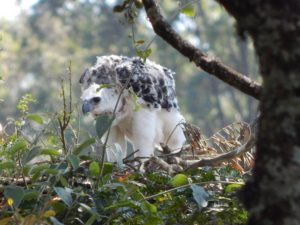
What are the main natural mortality causes for Crowned Eagles in the study area?
I must admit I have never recorded a mortality incident among my pairs in Nairobi, or even the other pairs I am monitoring across Kenya.
Natural mortality may be likely in the rural populations. However, in my urban setting, most likely causes are anthropogenic. I hope that by sharing my project with as many people as possible, we shall be able to reduce the possibility of any human-caused mortalities.
Are Crowned Eagles persecuted by humans or are there other human caused problems like electrocution?
Yes.
I have records from my predecessors where a Nairobi resident shot and killed an African Crowned Eagle for eating a pet cat. Farther from Nairobi, often in Western Kenya, local residents fear that the Crowned Eagles can pick up their lovestock, mainly goats and sheep. For this reason there are instances where they persecute the eagles and destroy their nests. One chick was rescued in the Tugen Hills, West Rift Valley Kenya, from such an incident. The chick is a fine male, being hosted by the Raptor Rehabilitation Centre, and will hopefully make it to fledging condition after professional rehabilitation.
I have not yet recorded Crowned Eagles electrocutions in Kenya, but I have recorded Yellow-billed Kites. Therefore, I believe elctrocution is a potential threat for the eagles. They often stray across the city centre- especially the young birds. Therefore, they can fall into trouble on the city expeditions.
How is the population doing in your study area?
The small Nairobi population is rather stable and has remained quite so during my period of studying the species. Even if we do not have good records of adult replacements and lifespans from the recent years, I have recorded successful breeding in each, except one, nest for every one-and-a-half year to two years-periods. This shows that the eagles are probably doing well; because they tend to breed slower here along the equator. In the south of the continent, they will probably breed more frequently than here at the Equator.
Historical records by my predecessors, here in Kenya, indicated that adult lifespans ranged 10-12 years.
In general terms, the species population is not doing so well. The species population is on constant decline across its entire range. In Kenya specifically, the species is Critically Endangered, and hopefully the country can designate this status officially soon. With all the threats facing it, coupled with the species slow reproduction rate, the population replenishment is very slow. Globally regarded as Near Threatened, this status may be biased by the fact that most pairs are known from the south of the continent where the population is doing better.
What do you see as the main threats for Crowned Eagles in your study area and the rest of East Africa?
Habitat loss is the major threat in East Africa. Most of the places where the species used to thrive are now developed and converted to estates or farmland. The rate of urbanisation in Kenya is definitely faster than we are prepared for as conservationists. The environment is struggling to keep up and most times species are loosing the battle.
Habitat destruction is real all across the continent, mainly from deforestation. Humans are constantly clearing large and more economically-viable trees. Unfortunately, these large trees are the more preferred nesting sites for the eagles too. Therefore, with every large tree that we cut, that is one more nest-site lost for our beautiful eagles.
Another major problem caused by humans is competition for food. Humans in all parts of the population range have been hunting the Crowned Eagles‘ prey items. This is causing a huge problem for the species- reduced food availability.
Negative perceptions from humans are also a threat worth noting in the region. During my study, I have been often told by the locals that the eagles eat their goats and lambs. They are therefore viewed as a threat to livestock and humans do not like them nesting near their villages for the fear they will prey on their animals.
How do you see the future of the Crowned Eagle in Kenya and beyond?
I believe there is hope for the species.
The species has a remarkable ability to bounce back and reclaim its habitat when the conditions impove. I have been inspired by the recovery of one specific population around Karura Forest, in Nairobi Kenya. The forest was very much degraded in the 1980s and the eagles fled. After conservation measures were put in place, which included the fencing of the forest, the eagles are now back and thriving.
This shows that the species is very resilient and capable of recovery every time the conditions are improved. If we keep working hard to repatriate our degraded ecosystems, the eagles will kick back and replenish their population on the continent.
I believe this is one of the most resilient species of eagles anywhere in the world.
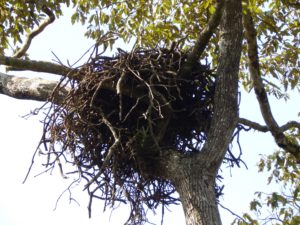
Photo by Washington Wachira
What are the main difficulties studying the eagles?
The eagles prefer a shy lifestyle and occupy forests and woodlands. Therefore, finding them is not easy. There are many interesting activities we are unable to observe well due to the eagles‘ lifestyle e.g. the detailed hunting techniques and mating/mounting activities (during my study, we have only managed to observe one mounting pair over the three years‘ period).
In my region, permits are not very easy to acquire and often require the researchers to limit what they can do in the field, as they study species. Therefore, some details of the studies are missed due to these limitations.
Due to the current IUCN classification as Near Threatened, many donors are more likely to fund studies into species that are ranked as Endangered or Critically Endangered. This thus limits the amount of funds available to keep studying the species and unveiling the details we do not know- from these activities, we can then prioritize conservation measures and policies for the species.
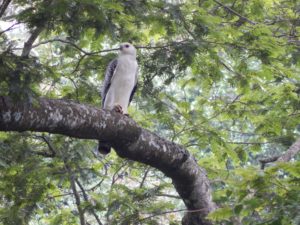
Photo by Washington Wachira
What was your most amazing experience with Crowned Eagles?
Observing Crowned Eagles being disciplined by their own prey species i.e. monkeys; has been my most memorable observations. This has shown me a whole new world of the eagles‘ life that I did not know when I was starting – the interactions between eagles and monkeys.
During the few years I have worked with the species I have recorded eagles receiving serious beatings from monkeys i.e. Olive Baboon and Kolb’s/ Gentle Monkey. We have one specific nest where the Gentle Monkey males have on several occassions been observed picking sticks from the eagle’s aerie and throwing them to the ground. I have interpreted this as a gesture that the eagles are not welcome to nest in that area. Being an often-picked prey item, the Gentle Monkeys must be very wary of the eagles; and hopefully by destroying nests they can send off their predator.
On another nest, Olive Baboons often walk from the main Nairobi National Park and cross the highway to a nearby forest. However, on their way back to the park, they pass under the local Crowned Eagles‘ nest. On several occasions, the dominant males climb the nest-tree and beat up the eagles chasing them out of the nest. On a few occasions, they do this when the eagles have mock-nested for long enough that I have thought the eagles had laid eggs. The baboons, I think, eat the eagle eggs on these nest raids. This could explain why that specific nest has not had a chick for over five years.
These nest-raids are not uncommon to my population; and I have observed the Kikuyu Guereza Monkeys raid a different nest and drive out a brooding female from her nest.
These predator-prey confrontations have, for me, been the most interesting part of my study. I hope to keep investigating these interactions further and hopefully unravel some unique aspects of the relationships.
Washington, many thanks for the interview!
ACKNOWLEDGEMENTS
The various forest management groups that allowed us access to study Crowned Eagles in their areas of jurisdiction over the many years that this data was collected; and all other partners: National Geographic Society, Kenya Wildlife Service, Kenya Forest Service, Friends of Karura Forest, Institute For Primate Research, Ngong Road Community Forest Association, Thogoto Community Forest Association and Ngong Hills Metro Community Forest Association. More input and assistance was shared by Dr. Harvey Croze and Dr. Peter Njoroge.
Washington would like to thank his university supervisors who have guided his work tirelessly: Dr. Munir Virani, Dr. James Jumbe and Dr. Jemimah Simbauni.
Video with Washington Wachira and Crowned Eagles:


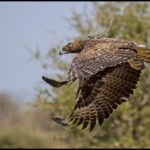
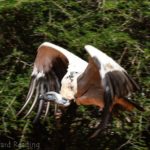

I have learned a lot from this Wachira’s research about African crown eagle. Thanks a lot to you Mr Wachira my former chair Kenyatta university birding club.